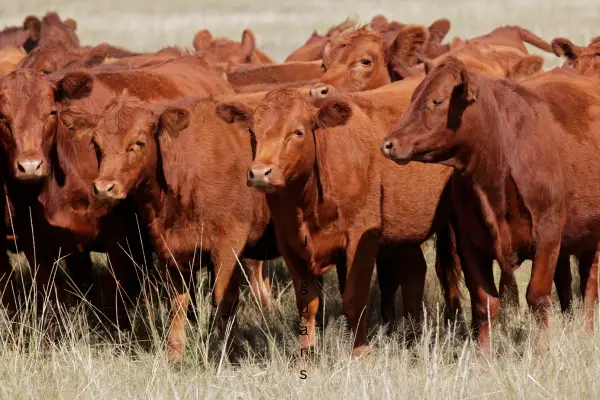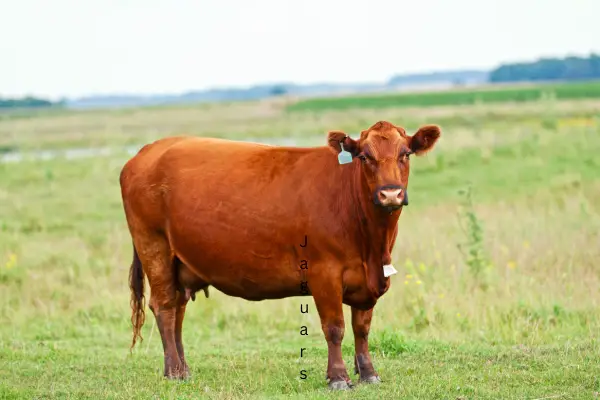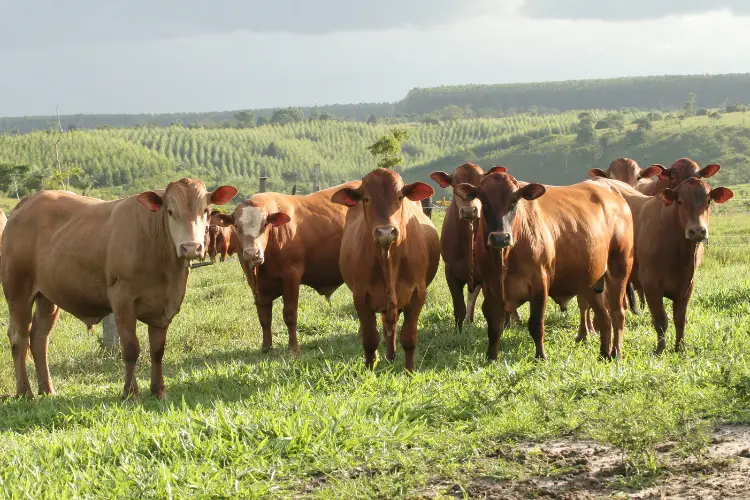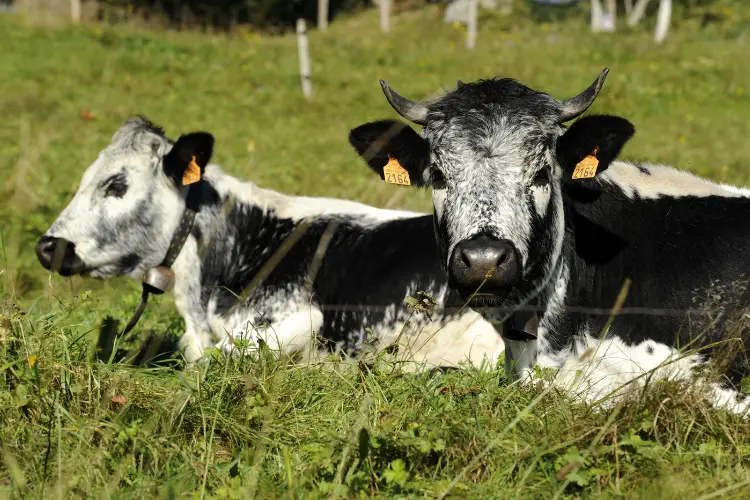The article ‘Discovering the Finest: An Insight into the Best Heritage Cattle Breeds’ delves into the world of heritage cattle, exploring their historical significance, genetic advancements, and the unique characteristics that set them apart.
It profiles some of the most renowned heritage breeds, examines the nuances of cattle breeding economics, and looks ahead to future innovations in the field.
In this blog post guide, we will provide a thorough understanding of heritage cattle breeds and their contribution to both traditional farming and modern agriculture.
Key Takeaways
- Heritage cattle breeds offer a unique combination of traits that contribute to sustainable agriculture and high-quality beef and dairy products.
- Genetic advancements play a crucial role in optimizing dairy and beef production, with a focus on health, efficiency, and profitability.
- The Charolais and Holstein breeds exemplify the pinnacle of heritage cattle, known for their beef and dairy prowess respectively.
- Consumer preferences are shifting towards heritage breed products, influenced by factors such as nutritional benefits and taste profiles.
- Innovations in cattle breeding technologies and sustainable practices are shaping the future of heritage cattle conservation and farming.
The Heritage of Quality: Exploring Heritage Cattle Breeds

Defining Heritage Cattle and Their Unique Traits
Heritage cattle breeds are living legacies of the agricultural past, each with a story deeply rooted in regional histories and cultures. These breeds are characterized by their adaptability, longevity, and genetic diversity, traits that have been honed over centuries of selective breeding and natural adaptation to local environments.
Unlike commercial breeds, heritage cattle often possess qualities that make them particularly well-suited to sustainable farming practices, such as resistance to disease and the ability to thrive on marginal pastures.
One such example is the Charolais breed, originating from Charolles in France. Known for its muscular build and impressive growth capabilities, the Charolais is a prime example of a heritage breed that has maintained its popularity due to its hardiness and quality beef production.
Another breed with a colorful history is the Red Poll, which is renowned for its excellent maternal instincts and ease of calving, as well as its docile disposition.
Heritage breeds play a crucial role in the biodiversity of livestock and offer a treasure trove of genetic traits that can be invaluable for future breeding programs. By preserving these breeds, we not only maintain a connection to our agricultural heritage but also ensure a reservoir of genetic material that could be critical for the resilience of future food systems.

The Role of Heritage Breeds in Sustainable Agriculture
Heritage cattle breeds play a pivotal role in the movement towards sustainable agriculture. Their genetic diversity and adaptability make them ideal for regenerative farming practices, which focus on restoring and enhancing ecosystem health. By integrating heritage breeds into these systems, farmers can leverage their natural resilience and efficiency, leading to a more balanced and self-sustaining agricultural model.
In the context of dairy farming, heritage breeds contribute to the regenerative agriculture approach by promoting soil health through rotational grazing. This practice not only improves pasture quality but also supports carbon sequestration and biodiversity. Moreover, the inherent hardiness of heritage breeds often translates to lower veterinary costs and reduced need for chemical inputs, aligning with the principles of organic farming.
The economic viability of incorporating heritage breeds into sustainable farming is also significant. While initial investments may be higher, the long-term benefits include increased farm profitability and resilience. Consumers are increasingly seeking out sustainably produced products, offering farmers the opportunity to differentiate their offerings and tap into premium markets. Below is a list of key benefits associated with heritage breeds in sustainable agriculture:
- Enhanced soil health and fertility
- Increased biodiversity and ecosystem resilience
- Reduced environmental footprint
- Lower input costs and higher yield potential
- Market differentiation through sustainable branding
Case Studies: Success Stories of Heritage Breed Preservation
The preservation of heritage cattle breeds is not just about maintaining genetic diversity; it’s a testament to the dedication and innovation of breeders worldwide. Success stories abound, from family farms to large-scale operations, all united by a commitment to heritage breed excellence.
One notable example is the Best Managed Herds program, which celebrates the achievements of individuals and their animals. This program highlights the spirit of excellence that drives long-term success in heritage breed preservation. The recognition of these herds serves as an inspiration and a model for sustainable breeding practices.
Another success story comes from the beef-on-dairy sector, where the integration of heritage breeds like Charolais and Limousin with dairy breeds has established a new standard for beef production.
This innovative approach has helped sidestep breed-specific discounts and maintain the value of beef-on-dairy calves, ensuring the viability of these heritage breeds in modern agriculture.
- Best Managed Herds Program
- Celebrates individual and animal achievements
- Inspires sustainable breeding practices
- Beef-on-Dairy Sector Innovations
- Combines heritage beef breeds with dairy
- Maintains value and demand for beef-on-dairy calves
The Science of Superiority: Genetic Advancements in Cattle Breeding

The Impact of Genetics on Dairy and Beef Production
The intersection of genetics and livestock production has revolutionized the dairy and beef industries. Optimizing genetic development is crucial for enhancing herd health and driving profitability.
By identifying and breeding top animals, farmers can remove unfavorable traits and produce high-value beef calves. This genetic selection is a cornerstone in the sustainability of dairy farms, where the average cost of raising a heifer can range from $2,000 to $4,000.
The ‘beef-on-dairy’ initiative illustrates the practical application of genetics in production. Utilizing sexed semen on top heifers and cows, while integrating beef genetics in the rest, creates a high-quality beef-cross. This approach helps in managing heifer inventories and maximizing returns.
The key traits sought in beef sires for this purpose include fertility, growth efficiency, and yield, which are critical for the profitability of both dairy and beef production.
| Trait | Importance |
|---|---|
| Fertility | Ensures cows conceive, vital for herd expansion |
| Growth Efficiency | Maximizes meat yield from feed inputs |
| Yield | Directly impacts profitability |
In summary, the strategic use of genetics not only preserves the quality of dairy and beef herds but also contributes to the economic viability of the industry. As such, the role of genetics in dairy and beef production is an ongoing journey of improvement and adaptation.
Top Genetic Traits Sought After in Elite Breeding Programs
In the pursuit of excellence within elite cattle breeding programs, certain genetic traits are highly coveted for their ability to meet market demands and enhance herd performance. Targeting market needs is a strategic focus, as seen in Select Sires’ XD program, which combines the best of Holstein and Jersey genetics for high efficiency cows.
This approach is not only about producing superior animals but also about optimizing genetic development and herd health.
The selection of elite sires is critical, as it allows breeders to access esteemed cow families and elevate their breeding programs. The average cost of raising a heifer can be substantial, making the optimization of genetic advancement a key factor in driving profitability. By identifying top animals and employing top genetics for replacement breeding, breeders can remove unfavorable characteristics and produce high-value beef calves.
To maximize the value of beef-x-dairy profit, it is essential to recognize and exploit traits that add value to the beef sire. A list of prioritized traits includes:
- Fertility
- Pricing
- Growth
- Efficiency
- Yield
Each trait contributes to the overall success of the breeding program, with fertility being of utmost importance to ensure cows conceive effectively. Genomics testing and a well-structured breeding plan are tools that can assist farmers in managing the complex process of selecting and breeding the finest animals.
The Economics of Breeding: Costs and Returns on Investment
In the realm of cattle breeding, the economics are as complex as the genetics that drive the industry. The average cost of raising a heifer can range from $2,000 to $4,000, a significant investment for any farmer. This cost underscores the importance of strategic breeding practices that focus on profitable matings and the production of high-value beef calves.
However, the economic landscape is not static. With feeder cattle prices reaching record highs in 2023, and the presence of high interest rates and an uncertain market, farmers are compelled to make calculated decisions. The sexed-and-beef approach is one such strategy that aims to optimize the genetic potential of the herd while keeping costs in check.
| Strategy | Average Cost | Expected ROI |
|---|---|---|
| Replacement Breeding | $2,000 – $4,000 | Variable |
| Sexed-and-Beef | Depends on semen cost | Higher due to premium beef-cross |
To maximize returns, it is crucial to select the best semen product that aligns with both short- and long-term business objectives. This involves using sex-sorted semen to enhance genetic improvement and carefully choosing which heifers to breed with beef semen to ensure a profitable outcome.
The Cream of the Crop: Profiling Top Heritage Cattle Breeds

Charolais: The French Beef Powerhouse
Originating from Charolles, France, the Charolais breed has become a global symbol of beef excellence. Known for their impressive size and distinctive cream or white coloring, these cattle are not only a sight to behold but also a producer’s dream. Their ability to thrive in various climates and their low maintenance needs make them a versatile choice for farmers around the world.
The Charolais breed’s contribution to the beef industry is significant, with a remarkable ability for crossbreeding. By introducing Charolais genetics, farmers can enhance the growth and muscularity of other beef cattle breeds, leading to more efficient meat production. Here’s a quick glance at the breed’s profile:
| Trait | Description |
|---|---|
| Average Bull Size | 2,200 to 3,600 pounds |
| Average Cow Size | 1,500 to 2,600 pounds |
| Lifespan | 15–20 years |
| Production | Beef, occasionally dairy |
With an estimated global population of 730,000, the Charolais stands as a testament to the enduring value of heritage breeds. In France, it ranks as the second-most numerous breed, showcasing its enduring popularity and the successful integration into various agricultural practices.
Holstein: The Dairy Dynasty
The Holstein breed, renowned for its remarkable milk production, stands as a pillar in the dairy industry. Holsteins are the quintessential dairy breed, producing more milk than any other, which is why they are often referred to as the ‘Dairy Dynasty’. Their black and white patched appearance is iconic, and their genetic traits are highly sought after for dairy operations worldwide.
Holstein genetics play a crucial role in the profitability of dairy farms. The average cost of raising a heifer can range from $2,000 to $4,000, emphasizing the importance of strategic breeding and herd management. By focusing on top genetics for replacement breeding, farmers can optimize genetic advancement and herd health, leading to increased profitability.
| Trait | Importance |
|---|---|
| Milk Yield | High |
| Udder Health | Critical |
| Longevity | Desirable |
| Fertility | Essential |
The future of dairy farming hinges on the continuous improvement of these traits, ensuring that Holsteins remain at the forefront of the dairy sector.
Texas Heritage Cattle: A Model of Nutritional Excellence
Texas Heritage Cattle breeds stand as a testament to nutritional excellence, offering a product that is not only delicious but also boasts significant health benefits. Discover Texas Heritage Beef, home to some of the healthiest FSIS, USDA, and State-approved beef. These cattle are naturally immune and provide meat with lower cholesterol levels compared to other meats, thanks to a diet rich in green grass and nutritious hay.
Chapman 3C Cattle Company exemplifies the unbeatable taste of all-natural meat, emphasizing transparency in food sourcing and the genuine flavors of Central Texas. Similarly, R-C Ranch is renowned for its commitment to quality, earning high esteem in Texas for its ethical and quality-focused practices.
For those interested in the specifics of maintaining such a high standard, here’s a glimpse into the nutritional strategies:
- Monitor daily diet, avoiding antibiotics and chemicals
- Employ time-honored ranching techniques
- Ensure a balanced diet rich in polyunsaturated and monounsaturated fats
- Implement a dry-aging process to enhance tenderness and flavor
S&G Farms is another example of excellence, producing some of the finest beef in the Texas panhandle. They also extend their ethical farming practices to other livestock, ensuring a wide range of high-quality meats. A delighted customer shares, “We’re thrilled with our purchase – large roast, steaks, sausages, and lamb – all fantastic!” For the healthiest, best-tasting, and most budget-friendly meat, S&G Farms is a destination not to be missed.
From Pasture to Plate: The Journey of Heritage Beef

The Art of Dry-Aging: Enhancing Flavor and Tenderness
The process of dry-aging beef is a time-honored technique that involves resting cuts of meat in a controlled environment to enhance their flavor and tenderness. During this period, natural enzymes break down the fibrous, connective tissue in the meat, which results in a more tender and flavorful steak.
One popular variation of this process is known as butter aging, where the steak is encased in butter during the aging process. This method adds a unique richness to the meat and can protect it from over-drying. Here’s a brief guide on how to handle butter-aged steak:
- Trim and prepare: Once the aging process is complete, remove the butter from the steak and carefully trim any dried or discolored outer layers. Butter aging can enhance the meat’s flavor profile, creating a steak that’s both succulent and aromatic.
- Cook to perfection: After trimming, cook the steak to your desired level of doneness, allowing the deep flavors achieved through dry-aging to shine through.
Dry-aged beef is not just a gourmet preference but also a testament to the culinary heritage that heritage cattle breeds bring to the table. By choosing to dry-age their beef, producers honor the tradition and quality inherent in these breeds, offering consumers an exceptional eating experience.
Grass-Fed vs. Grain-Fed: Nutritional Profiles of Heritage Beef
The debate between grass-fed and grain-fed beef is not just about taste preferences but also nutritional differences. Grass-fed cattle are typically leaner, offering meat with lower fat content and fewer calories. This aligns with the desires of health-conscious consumers who seek variety and a high-quality diet.
When comparing the nutritional profiles, grass-fed beef is often higher in certain nutrients. It is rich in polyunsaturated and monounsaturated fats, which are considered healthier fats. Moreover, grass-fed beef tends to have less cholesterol than other meats, making it a preferable choice for those monitoring their cholesterol levels.
Here’s a quick comparison of the nutritional content in grass-fed versus grain-fed beef:
| Nutrient | Grass-Fed Beef | Grain-Fed Beef |
|---|---|---|
| Total Fat | Lower | Higher |
| Calories | Fewer | More |
| Cholesterol | Less | More |
| Healthy Fats | Higher (polyunsaturated and monounsaturated) | Lower |
Choosing between grass-fed and grain-fed beef may depend on individual dietary goals and preferences. However, the nutritional superiority of grass-fed beef is clear, especially for those prioritizing a healthier lifestyle.
Consumer Trends: The Growing Demand for Heritage Breed Products
In recent years, the market has witnessed a significant shift towards heritage breed products. Consumers are increasingly seeking out meats with authentic flavors and sustainable origins, a trend that is reshaping the protein market.
This growing demand is reflected in the stagnation of sales for plant-based meat alternatives, as reported by The National Provisioner, indicating that the allure of real meat’s flavor and texture continues to hold strong sway over consumer preferences.
Heritage breeds, with their unique genetic traits and storied histories, are becoming a symbol of quality in the meat industry. For instance, the Charolais and Holstein breeds are not just sought after for their superior beef and dairy qualities, but also for the value they add to crossbreeding programs, enhancing the genetic diversity and robustness of offspring.
The economic implications of this trend are profound. As consumers are willing to pay a premium for heritage breed products, farmers and producers are adapting their strategies to cater to this niche market. The table below illustrates the potential financial benefits of investing in heritage cattle breeds:
| Breed | Average Premium Price per Pound | Market Growth Rate |
|---|---|---|
| Charolais | $5.50 | 3.5% |
| Holstein | $4.75 | 2.8% |
| Texas Longhorn | $6.00 | 4.2% |
As the market for heritage breeds expands, it is essential for producers to stay informed about emerging trends and consumer behaviors to capitalize on this lucrative opportunity.
The Future of Farming: Innovations in Heritage Cattle Breeding

Emerging Technologies in Cattle Genetics and Reproduction
The intersection of cattle genetics and reproduction is witnessing a transformative era, with emerging technologies propelling the industry towards unprecedented efficiency and precision.
Genomic testing has become a cornerstone in identifying the most elite genetic animals within dairy farms, enabling farmers to make informed decisions about which animals to breed and with what semen. This practice not only enhances genetic advancement but also drives profitability by optimizing herd health and production traits.
In the realm of semen selection, sexed semen is revolutionizing the way dairy producers approach herd management. By using sexed semen on the top heifers and cows, farmers can lower heifer inventories while maximizing returns through the production of high-quality beef-cross calves. The table below outlines the key benefits of employing sexed semen in dairy production:
| Benefit | Description |
|---|---|
| Genetic Improvement | Ensures the next generation inherits the best traits. |
| Herd Health | Reduces the spread of unfavorable characteristics. |
| Profitability | Increases the value of beef calves and dairy replacements. |
The economics of breeding are not to be overlooked, with the average cost of raising a heifer ranging from $2,000 to $4,000. A strategic breeding plan, guided by genomic testing and the use of sexed semen, can significantly enhance the return on investment by ensuring that only the top animals contribute to the genetic pool.
As the industry continues to evolve, these technologies will play a pivotal role in shaping the future of heritage cattle breeding.
Sustainable Practices for Heritage Breed Conservation
In the quest for sustainability, heritage cattle breeders are turning to holistic management practices that prioritize the health of the ecosystem. Holistic management for cattle ranching is not just a strategy; it’s a commitment to enhancing land fertility, water retention, and overall ecosystem health.
This approach is particularly effective in dairy farming, where rotational grazing plays a pivotal role. By systematically moving livestock through different paddocks, farmers allow for the natural regeneration of pastures, leading to improved forage quality and increased biodiversity.
Adopting regenerative agriculture practices in dairy farming is a step towards mitigating environmental degradation. These practices, which include rotational grazing, aim to restore soil health and sequester carbon, thereby enhancing the resilience of farming operations.
The benefits are manifold: reduced erosion, better nutrient cycling, and a more robust ecosystem capable of supporting diverse wildlife.
The following points highlight key sustainable practices:
- Implementation of rotational grazing to improve soil health
- Adoption of regenerative agriculture principles to restore ecosystem balance
- Emphasis on humane and environmentally safe practices for raising cattle
- Minimization of carbon footprint through local processing facilities
By integrating these practices, heritage cattle breeders contribute to a more sustainable and environmentally conscious approach to farming, ensuring the longevity and purity of these treasured breeds.
Predicting the Next Big Thing in Heritage Cattle Breeds
As the agricultural sector evolves, so does the interest in heritage cattle breeds. Predictive analytics is becoming a cornerstone in identifying which breeds will lead the future of farming. By analyzing data trends and genetic markers, experts can forecast the breeds that will thrive in changing environmental conditions and meet consumer demands.
One such breed gaining attention is the Baladi cattle, known for its adaptability and resilience. Recent studies suggest that while heritage breeds like Baladi are less common than conventional breeds such as Angus, they offer unique advantages that could be pivotal in sustainable agriculture.
- Heritage Breed: Baladi
- Traits: Adaptability, Resilience
- Comparison: Less common than Angus
- Potential: Sustainable agriculture
The future of heritage cattle breeding is not just about preserving the past; it’s about shaping a sustainable and efficient future for the industry. The breeds that will emerge as leaders will likely be those that can balance productivity with environmental stewardship and animal welfare.
Conclusion
In our journey through the rich tapestry of heritage cattle breeds, we’ve uncovered the remarkable qualities that make these animals not only a testament to agricultural history but also a vital part of contemporary farming and gourmet cuisine.
From the robust and versatile Charolais, with origins steeped in French history, to the elite herds of English dairy cattle, and the nutritional superiority of Texas Heritage Beef, these breeds exemplify the pinnacle of genetic refinement and breeding excellence. The insights gained from the USDA’s agriculture census and the forward-looking strategies of Lactanet’s top herds remind us of the importance of genetics and herd management in shaping the future of dairy and beef production.
As we consider the cost of raising heifers and the traits that define the best beef sires, it’s clear that heritage cattle breeds offer not just a link to the past, but a blueprint for a sustainable, profitable, and health-conscious future in livestock farming.
FAQs:
What are heritage cattle breeds and why are they important?
Heritage cattle breeds are traditional livestock breeds that have been passed down through generations. They are important because they often possess unique traits such as disease resistance, adaptability to local environments, and high-quality meat or milk production, which can be crucial for sustainable agriculture and biodiversity.
How does the dry-aging process affect the quality of heritage beef?
The dry-aging process enhances the flavor and tenderness of heritage beef by allowing natural enzymes to break down muscle tissue. This results in a more concentrated flavor and a buttery texture, making the meat a delicacy for consumers.
What are the nutritional benefits of Texas Heritage Cattle beef?
Texas Heritage Cattle beef is known for its low saturated fat content and lower cholesterol levels compared to other meats. It is rich in polyunsaturated and monounsaturated fats, which are healthier fat options, contributing to its nutritional superiority.
What genetic traits are top breeding programs looking for in cattle?
Top breeding programs prioritize traits such as fertility, milk yield, growth efficiency, disease resistance, and meat quality. These traits are selected to improve herd health, optimize production, and increase profitability.
What is the average cost of raising a heifer in today’s market?
The average cost of raising a heifer ranges between $2,000 and $4,000. This cost includes feeding, housing, health care, and other expenses associated with raising a healthy and productive cow.
What makes Charolais cattle a top choice for beef production?
Charolais cattle are favored for beef production due to their ruggedness, hardiness, and muscular build. They are low maintenance and have a high meat yield, making them an efficient and profitable choice for farmers.


